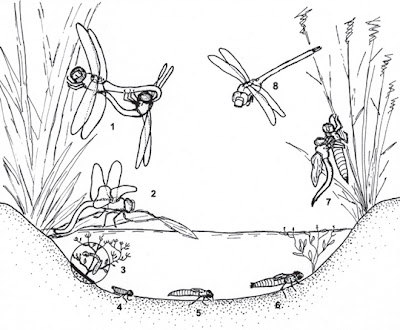Life Cycle of A Dragonfly
(Drawing: M. Bedjanič)
(1) Mating (2) Egg-laying (3-6) larval development
(7) last moulting – emergence (8) adult insect
The dragonfly has an incomplete metamorphosis, which consists of egg and several larval stages followed directly by the adult phase. Adult phase is characteristic of dragonflies. Dragonfly is an insect whose adult wings are beautifully colored. It can be met along rivers, streams, paddy fields, marshes, pools and lakes almost year round, represent only the shorter phase of their life cycle. They spend most of their lives hidden from human eyes as larvae in the water.
Female adult lays eggs in plant tissue or drops freely into the water. Larvae develop from eggs. The first larva, Nymph 1 is very small. After passing several moults the larva becomes proportionally larger. It’s Nymph 2. Larvae appear as a rough bodied clumsy looking creature with spidery legs and have very little in common with the beautiful winged adults. Both larvae and adults are ravenous and predatory animals. Larva has a modified lower lip, which is folded beneath the head at rest but can grasp prey with lightning speed. They eat small aquatic insects, such as mosquito larvae, and sometimes they feed on smaller fishes.
When the wings of the larva ready to emerge, it climbs out of the water and emerge from the tight larval case. Though it expands its soft wings and flies away, its wings aren’t developed brighter colours. Their attractive colouration develops only after several days of their emergence. Male dragonflies are usually found near aquatic surroundings. As well as feeding, they are very active in finding a female. Female are found on the water when they mate or lay eggs, except these occasions they are fond of living away from the water and feed at forest edges and clearing to avoid contact with the male.
it’s an interesting act in the nature, mating in dragonflies. The primary sexual organs of both male’s and female’s, are situated at the end of the abdomen. They aren’t in direct contact during mating. Underneath the second and third abdominal segment, the male has so called secondary genital organs where sperm is transferred from the abdomen tip. The female, still securely held by the male’s anal appendages, bends her abdomen and genitalia to the secondary genitalia of the male and the partners are joined. This beautiful heart-shaped figure is called a “wheel” or “copula”.




Dear Sir,
ReplyDeleteWith your kind permission, can i use the figure "life cycle of dragonfly" for developing educational material? The source of the image will be mentioned.
Dr. Anjana Singha Naorem
Miranda House
University of Delhi